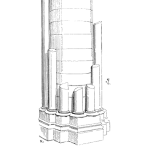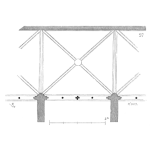
Below is an excellent safety message about driving safely (Courtsey: Paul Koyich).
[Read more…]Your Reliability Engineering Professional Development Site
Find all articles across all article series listed in reverse chronological order.
by Sanjeev Saraf Leave a Comment
by Carl S. Carlson Leave a Comment

Are generic lists of failure information useful to FMEA teams? Are they a good idea or not?
There is a lot of discussion amongst FMEA practitioners on automating and standardizing FMEAs. In this article, I will discuss the pros and cons of using generic lists of failure modes, effects and causes.
The Oxford English dictionary defines “generic” as “characteristic of or relating to a class or group of things; not specific.” [Read more…]
by André-Michel Ferrari Leave a Comment

Assets typically age over time, leading to degraded performance and loss of function. Asset life models are built in order to predict future degradation patterns. Those models are based on asset degradation variables such as time or usage. Those variables could be for example, time between failures or distance covered between failures. Many assets have more than one degradation variable. In this case, it is important to define which of the multiple variables is the dominant one and will subsequently provide the Reliability Engineer with the most precise life model.
Reliability is a probability. Specifically, the probability that a system will perform its intended function within a specified mission time and under specific process conditions. Therefore, most reliability calculations incorporate a time element as a degradation variable. Generally, when building life models, we default to using calendar time as it is more straightforward. We have had tools to easily measure elapsed calendar time for centuries now. [Read more…]
by Christopher Jackson Leave a Comment

Climate change is universally accepted. And when I say ‘universally,’ I mean that the only people who think it is not a thing are fringe elements of society who are predisposed to specific interpretations of religion or commercial greed that would be harmed by any attack on fossil fuels and the energy we derive from them.
The good thing about this is that organizations who are serious about being successful and profitable can’t do so by sharing the ideology of a small minority. More and more people (including younger humans who will be the decision makers of tomorrow) are demanding more and more from the organizations they buy services and products from – especially when it comes to environmental concerns.
So to be successful, you need to take this stuff seriously.

FINESSE is a cause-and-effect approach for effective communication when there are high levels of complexity and uncertainty. Said another way, FINESSE is an approach used for big, strategic decisions that take months or years to make. FINESSE facilitates the memory of effective communication: Frame, Illustrate, Noise, Empathy, Structure, Synergy, and Ethics.
Major decisions that take months to resolve, require a significant amount of investment, and involve many people (and some calculations) have complexity and uncertainty. These are the situations where trusted advisors need FINESSE. [Read more…]
by Arun Gowtham Leave a Comment

The falling cost of sensors for Industrial Equipment & the popularity of AI-based solutions means that Organizational teams are defaulting to using this strategy on all their Equipment, regardless of its criticality or other effectiveness. This is a strategic error.
[Read more…]by Mike Sondalini Leave a Comment

You must select OHS risk management mitigations appropriate to a job safety hazard using a formal method that delivers safe work practices.
Each task safety control will need to be developed, assessed for suitability, and recorded so it’s clear what the plan is, and how it is to be done.
In the end, there is a practically designed, completely resourced, fully scheduled, and totally sure safe work practice procedure approved for use.
[Read more…]by Greg Hutchins Leave a Comment

Risk…it’s everywhere whether the risks are known or unknown, foreseeable or unforeseeable but, as the saying goes, “one person’s risk is another’s opportunity”.
Within this risk-opportunity spectrum we have the risk averse, the risk seeking as well as those who purport to manage risk for their business or personal lives.
We also have those who believe that risk is something that happens to other people and those who believe that Murphy’s Law will always apply to them, always, at all times, and in every circumstance.
[Read more…]by Larry George Leave a Comment

Generations of products have similar field reliability functions because they are designed, processed, shipped, sold, and used in similar environments by similar customers. Replacement parts have similar reliability functions depending on replacement number: 1st, 2nd,….
Biostatisticians use David Cox’ proportional hazard (PH) survival function models to quantify effects of treatment or risk factors. Proportional hazard models could describe product’s failure modes, parts’ reliabilities in successive replacements, or products’ reliabilities in successive generations. [Read more…]

As engineering professionals, we’re no strangers to complex problem-solving scenarios that demand rigorous analysis, innovative thinking, and efficient decision-making. Whether it’s designing new components, optimizing processes, or addressing infrastructure challenges, our success hinges on our ability to approach problems with a structured and creative mindset.
One method that can significantly boost our problem-solving prowess is the “Six Hats Method” – a systematic approach that allows us to don different thinking hats, unlocking diverse perspectives for comprehensive and effective solutions. Let’s see how the Six Hats Method can empower engineering professionals to navigate challenges with clarity, focus, and ingenuity.
[Read more…]by Sanjeev Saraf Leave a Comment

In a number of my previous blog posts, I have emphasized the disturbing trend of fires and explosions in the biodiesel and biofuel industry.
Based on the statistics, the biodiesel industry in the US is experiencing an incident every two-and-a-half months, i.e. approx. 10 weeks.
[Read more…]by André-Michel Ferrari Leave a Comment

The concept of Reliability Block Diagrams (RBD) is also known as Reliability Modeling or Reliability, Availability, Maintainability (RAM) analysis. With RAM models, the interaction of large, complex, and multi-layered systems can be analyzed using Monte Carlo simulation methods. This help quantify the output of the entire system with greater accuracy than other estimating tools or methods. [Read more…]

Using shapes as a deceptive communication practice is an old trick used for manipulation by one side of an argument. The good news is that Fortune gets it right in its annual publication of Fortune 500 companies. Fortune correctly uses two-dimensional shapes (circles) to depict one-dimensional values such as annual revenues. We’ll discuss this data visualization trick in this brief article.
Suppose your total revenues were $100 per month, and your leading competitor had total revenues of $10 per month. Clearly, you are ten times stronger from a total revenue perspective from your competitor. A one-dimensional graph, such as a bar chart, makes an honest visual representation of the difference.
[Read more…]by Gabor Szabo Leave a Comment

Hopefully, you have already seen that utilizing R for engineering can unlock a host of powerful tools and techniques and give you the power of data visualization.
In using R, you will likely work with various objects (data files, scripts, analyses, reports etc.). As with other things, creating structure for how you accomplish things in R can be important for both effectiveness and efficiency.
[Read more…]by Arun Gowtham Leave a Comment

In the previous article, P-F Curve was used to understand the Remaining useful life (RUL) of an asset. RUL can be estimated at any time during the asset’s life, but it’s opportune to calculate RUL at the time ‘t’ when the asset shows signs of an impending failure. In the P-F Curve terminology the point at which the asset shows signs of failure is called the Potential Failure Point (Pf), which can also be stated as the time of anomalous behavior. The exercise of detecting anomalous behavior is called “Anomaly Detection (AD)”.
[Read more…]